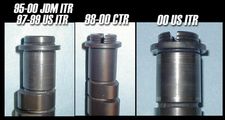
Here, I've gathered pics of various DOHC VTEC camshafts. This will help the average Joe identify DOHC VTEC cams by certain characteristics. This should help out a lot of you, who are buying any type of used or new VTEC cams from some stanger...
Looking at he distributor-side of the camshafts, you will find distinctive markings. There are two sets of visible markings, which I like to refer to as engraved rings and protruding rings - see image directly below.

Here, I've gathered pics of various DOHC VTEC camshafts. This will help the average Joe identify DOHC VTEC cams by certain characteristics. This should help out a lot of you, who are buying any type of used or new VTEC cams from some stanger...
Looking at he distributor-side of the camshafts, you will find distinctive markings. There are two sets of visible markings, which I like to refer to as engraved rings and protruding rings - see image directly below.
These rings basically help in telling you what engine year(s) the cams originated from. However, the lobe specs, seem to differ throughout the years. Meaning the lobes get better in spec. Some JDM cams have a more aggressive cam lobe profile when compared to US DOHC VTEC cams. You can definitley go by this rule of thumb: The newer the engine year, the better the cam profile. BTW, any 'R' cam will out perform any stock VTEC cam on a naturally aspirated engine setup.
The thumbnails below will show you the different engraved markings of each cam I have come across in the past. If you notice, all of the cams listed below are from 5-speed engines. I do not show any AUTO DOHC VTEC cams simply because....they SUCK! I happened to snake a couple pics of a TODA spec-B intake cam, thanks to Eddy L.! Enjoy.



Note:
• CTR & ITR cams both share the same exhaust cam.
• The 00/01 US ITR intake cam is a new addition. The markings are almost that of a CTR intake cam. I've checked the VTEC lobe and it's oh-so very close to the spec of a CTR cam. This cam has it's own spec, meaning it's not like like the 96-99 US ITR int. cam. This 00/01 cam will produce a tad bit more power than previous years...
• Honda of Japan is actually the maker of Spoon cams. Spoon has their own spec, which they give to Honda, and Honda manufactures them. That is why a Spoon cam material looks exactly like factory OEM Honda cam! This is unique, because you won't see TODA/JUN/ or even Mugen cams that look like OEM material.
• Toda cams are totally different than any of the 'R' cams. Notice how the secondary lobe has almost the same lift as the VTEC (middle) lobe...nutty! Once dynoed and dialed in, spec-B's produces some real good mid-range power. According to one of my friends, it makes a 1.6L engine almost feel like a 1.8L engine...




Note:
• The 89-91 B16A cam lobe profiles are the weakest of the bunch. All of them are weaker - whether you have a 1-series or 5-series 89-91 B16A engine. If you can get a set of newer cams, I highly advise it.
• A majority of the 92+ B16A/B17A and 94+ B18C (JDM +US) cam profiles are pretty much the same. Although, the 94+ B18C cams seem to put out a bit more power....just a little bit. Dyno-testing is the best way to tell between these stock cams. Again, 'R' cams are best to have over these....
• Your best bet over any of the stock cams is to purchase a set of 'R' cams. Those blow away any of the stock cams - about 7hp on an naturally aspirated VTEC engine. Of course, if you want more cam power, try Spoon or Toda. Just make sure you get the proper valvetrain to work with those bigger cams or else you can end up with damaged valvetrain components!
• One thing I'd like to mention is that, JDM aftermarket VTEC cams were mainly designed for circuit racing (roadracing in laymen terms). I always here people complaining about the high prices of JDM cams and engine parts. People need to understand that these are high quality parts and a lot of R&D is involved. The Japanese are all up on the road course racing tip and not too much into drag. Although, there are a few Japanese drag race companies, but I'm compelled to talk about that. My point is that, when people dyno their cars with these JDM aftermarket cams, such as Toda or Spoon, and they don't see the top-end power that they were anticipating to see, they should know why. Most of these cams are designed for mid-range power, which is needed on the circuit. So, not all JDM aftermarket cams are the right ones for your type of racing.